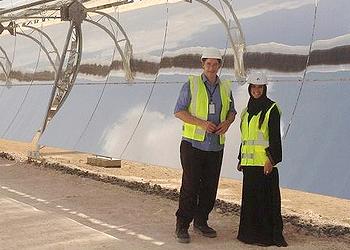
By Jonathan Porritt, Co-Founder, Forum for the Future
ABU DHABI, United Arab Emirates, December 26, 2012 (ENS) – I am seriously delighted at this photo. That’s me and Dr. Nawal Al-Hosany standing by one of the 258,048 mirrors that make up the Shams1 Concentrated Solar Power plant in Abu Dhabi.

It will be the biggest concentrated solar power plant in the world, stretching out over 2.5 square kilometers (0.965 square miles), and generating 100 megawatts of electricity when it goes on line.
[Shams1 will be completed by the end of 2012 and is expected to be officially inaugurated in the first quarter of 2013. It is a flagship project of Masdar, an Abu Dhabi government-owned corporation.]
Dr. Nawal is director of the Zayed Future Energy Prize, and Masdar is the driving force behind the many different initiatives going on in Abu Dhabi to promote sustainable energy.
Which makes it all just a little bit weird. The emirate of Abu Dhabi is one of the biggest oil producing entities in the world. As I was standing there, I kept thinking that in all likelihood there was a vast puddle of oil below my feet, just waiting to be extracted, refined, shipped and burned in some of the world’s ever-growing number of cars.
I’ll return to that in a minute. But first let’s just celebrate this beautiful, forceful power plant springing up out of the Abu Dhabi desert.
At one level, it’s all quite simple. The 258,048 mirrors are assembled in parabolic troughs that track the passage of the sun from dawn to dusk.
They ‘concentrate’ the sunlight onto tubes running down the middle of the troughs. These tubes are full of oil which is heated by the sun to nearly 400 degrees Celsius. Heat exchangers then convert that heat into steam, which drives the turbine, which drives the generator which produces the electricity.
It’s not quite as simple as that! There’s a lot of fancy engineering to get from sunshine to electricity, and I was astonished by just how big and complex that makes a plant of this kind.
We were there at around midday, so it was seriously hot – you couldn’t stand next to the mirrors for very long! But it was also dusty – it is, after all, in the middle of a desert. And that poses a huge challenge in terms of keeping the mirrors dust-free so that their performance is not affected. That means they’ve had to develop special vehicles that are constantly tracking up and down the 120 km length of parabolic troughs to keep them sparkling.
In short, it’s not easy. And it’s expensive. But as one of our fellow visitors said, “what do you expect with a nuclear reactor?”
I’ve often described the sun as “the only fusion reactor we’re ever going to need to power the world,” and that doing it this way is a whole lot simpler than trying to build our own puny little fusion reactors. It’s still an engineering triumph.

And all done courtesy of Abu Dhabi’s massive oil revenues – which have inevitably prompted people to level charges of hypocrisy against the whole Masdar initiative.
What is the value of 100 MW of solar set against the emissions of millions of tonnes of CO2 and other greenhouse gases from all that oil?
Fair point. But what conclusions should we draw from it? That Abu Dhabi should stop producing oil? Let’s not be too naive here.
That Abu Dhabi shouldn’t do anything to promote renewables – either from an R&D point of view or through schemes like Shams? Or through the Zayed Future Energy Prize, which celebrates the achievements of the best initiatives and organisations involved in renewable and sustainable energy all around the world? That would seem to be a bit self-defeating.
For me, near-zero carbon electrons from Abu Dhabi is just one of those sustainability paradoxes that you have to live with. Which is why I am looking forward to Shams1 being the first of a whole generation of concentrated solar power plants around the world.
[Ed. Note: Masdar owns 60 percent of Shams1, the French multinational oil and gas company Total owns 20 percent, and the Spanish multinational corporation Abengoa owns 20 percent.]
{Jonathon Porritt is a writer, broadcaster and commentator on sustainable development. He co-founded the sustainable development charity Forum for the Future in 1996. He is also co-director of The Prince of Wales’s Business and Sustainability Programme which runs seminars for executives. He is a Trustee of the Ashden Awards for Sustainable Energy, and is involved in the work of many NGOs and charities as patron, chair or special adviser. Contact him at: www.jonathonporritt.com}
Copyright Environment News Service (ENS) 2012. All rights reserved.
